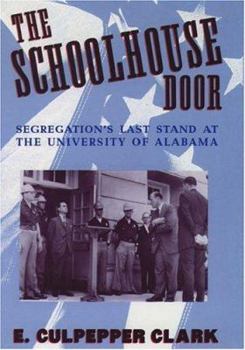The Schoolhouse Door: Segregation's Last Stand at the University of Alabama
Select Format
Select Condition 
Book Overview
On June 11, 1963, in a dramatic gesture that caught the nation's attention, Governor George Wallace physically blocked the entrance to Foster Auditorium on the University of Alabama's campus. His intent was to defy Attorney General Nicholas Katzenbach, sent on behalf of the Kennedy administration to force Alabama to accept court-ordered desegregation. After a tense confrontation, President Kennedy federalized the Alabama National Guard and Wallace...
Format:Hardcover
Language:English
ISBN:0195074173
ISBN13:9780195074178
Release Date:June 1993
Publisher:Oxford University Press, USA
Length:352 Pages
Weight:1.60 lbs.
Dimensions:1.3" x 6.4" x 9.5"
Related Subjects
20th Century African Americans African-American Studies Biographical Biographies Biographies & History Biography & History College & University Education Education & Reference Higher & Continuing Education History Political Science Politics & Social Sciences Schools & Teaching Social Science Social Sciences Specific Demographics State & Local TextbooksCustomer Reviews
1 rating
The in-depth story of barring the schoolhouse door
Published by Thriftbooks.com User , 17 years ago
This was required reading for a graduate course in American history. E. Culpepper Clark's The Schoolhouse Door is a narrative account of how The University of Alabama was integrated. In this detailed book Clark tells the story of the University's integration in two distinct parts. Part one tells the story of Autherine Lucy's acceptance to the University and of her swift expulsion. Clark examines how the board of trustees was successful in keeping Lucy out of the university. Part two focuses on George Wallace's stand at Foster Auditorium in June 1963. Clark documents the forces behind-the-scenes that orchestrated this infamous event. One of the author's purposes in writing this book is to debunk the idea that the University of Alabama was helpful in its own integration. Clark argues that the university desegregated its students only after immense outside pressure forced the institution to stop segregation. In the book the reader will find information on the major and minor figures who contributed to the end of segregation at the University of Alabama. The Schoolhouse Door offers the reader sound descriptions of the events and of the people who were a part of, " ... how Tuscaloosa became the Appomattox of segregation" (xix). E. Culpepper Clark is highly qualified to write on this particular topic. Clark is currently the Dean of Communication and Information Sciences at the University of Alabama. He has worked for the university in a number of different positions since 1971 and was the Executive Assistant to the President from 1990-1996.1 Wallace's stand at the schoolhouse door is an incredibly important piece of The University of Alabama's history. Furthermore, the integration of the university stands as a lasting symbol of federal vs. state authority. Clark sets the tone of this book in the introduction, " ... Alabama was a microcosm of the larger South, as ardently committed to white supremacy as Mississippi, but more vulnerable to change by virtue of its social and economic composition" (xii). Clark argues that the struggle for integration in Tuscaloosa was a relatively peaceful and a symbolic victory over Southern segregation. The first part of The Schoolhouse Door examines how Oliver Cromwell Carmichael, the university's president, was caught in the middle of the battle for integration. Carmichael was essentially a non-factor in the university's road to integrate because he did what the board of trustees told him to do. The members of the board of trustees legally delayed integration as long as possible to avoid integration. In 1952 Pollie Myers and Autherine Lucy applied to the University of Alabama, but did not indicate that they were black. They were accepted and they even paid the five dollar deposit on their dormitories. Once the Office of Admissions found their mistake it was immediately taken to the president (at the time, President Gallalee) with hope that the situation could be averted. However, the girls were backed by the NAACP





